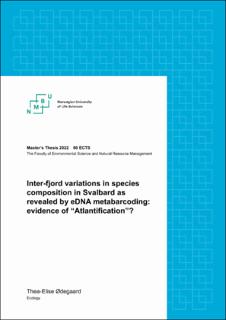| dc.description.abstract | Marin ecosystems faces mass extinction from climate change, and the Arctic marine ecosystems have experienced non-linear change the last decade. “Atlantification”, movement of warm and saline water being moved northward by the West Spitsbergen Current (WSC), has led to alteration of the Arctic marine environment and northward movement of Atlantic and sub-Arctic fish species. Knowledge of species distribution is critical to ecological management and conservation biology. Effective management requires the detection of populations, and biodiversity monitoring is necessary to provide baselines for policies. Recently, there has been considerable interest in the detection of short species-specific environmental DNA (eDNA) fragments to allow aquatic species monitoring within different environments due to the potential of greater sensitivity over traditional survey methods which can be invasive, time-consuming and costly. As well as have limitations in detecting species of low densities and is usually based on visual detection and counting.
Water was sampled from two distant fjords in Svalbard, the high-Arctic Rijpfjorden and the sub-Arctic Kongsfjorden to compare patterns of fish biodiversity between the areas. Because of the distant location of the fjord there was expected to be observed difference in species composition, and “Atlantification” was expected to have had a larger impact on the species composition in Kongsfjorden than in Rijpfjorden, whereas Rijpfjorden was expected to be dominated by Arctic species. eDNA was isolated from 1 L per 3 replicates of seawater sampled close to the sea floor from a total of seven stations divided into three sampling groups, three in Kongsfjorden, three in Rijpfjorden and one north of Rijpfjorden. A 170 bp fragment of the mitochondrial 12S ribosomal RNA (rRNA) was used as target region for species detection. Using next-generation DNA sequencing of PCR amplicons, 46 Molecular Operational Taxonomic Units (MOTUs) and 13 fish species were detected. There was found significant differences between temperature, salinity, and depth between all three sampling groups. Although, the significant difference in temperature and salinity was between Rijpfjorden Inner and the two other groups, while significant difference in depth was found between Kongsfjorden and the two Rijpfjorden groups. Despite this there was found no significant difference in biodiversity between the three sampling groups, neither for within- group dispersal or for the mean of the groups. This shows that there was considerable species overlap between the sampling groups, but Atlantic and sub-Arctic species were more dominating in Kongsfjorden than in Rijpfjorden, while the inner parts of Rijpfjorden were dominated by Arctic species. The data supports the hypothesis that the fish community in Kongsfjorden was dominated by north Atlantic and sub-polar species, while in Rijpfjorden it was more dominated by Arctic species. This indicates that Rijpfjorden might be more isolated from the “Atlantification” processes, but Kongsfjorden may serve as an analogue for the future of the northern fjords in Svalbard. | en_US |

